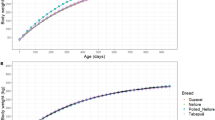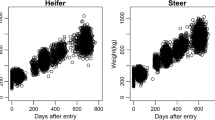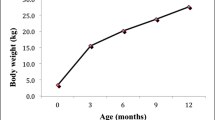Abstract
The body mass growth of organisms is usually represented in terms of what is known as ontogenetic growth models, which represent the relation of dependence between the mass of the body and time. This paper discusses design issues of West’s ontogenetic growth model applied to a Holstein-Friesian dairy farm in the northwest of Spain. D-optimal experimental designs were computed to obtain an optimal fitting of the model. A correlation structure has been included in the statistical model due to the fact that observations on a particular animal are not independent. The choice of a robust correlation structure is an important contribution of this paper; it provides a methodology that can be used for any correlation structure. The experimental designs undertaken provide a tool to control the proper weight of heifers, which will help improve their productivity and, by extension, the competitiveness of the dairy farm.



Similar content being viewed by others
References
Amo-Salas M, López-Fidalgo J, Porcu E (2013) Optimal designs for some stochastic processes whose covariance is a function of the mean. Test 1:159–181
Atkinson AC, Fedorov VV (1975) Optimal design: Experiments for discriminating between several models. Biometrika 62:289–303
Boukouvalas A, Cornford D, Stehlik M (2014) Optimal design for correlated processes with input-dependent noise. Comput Stat Data Anal 71:1088–1102
Cressie N (1993) Statistics for spatial data. Wiley, New York
Chernoff H (1953) Locally Optimal design for estimating parameters. Ann Math Stat 24:586–602
Demidenko E (2004) Mixed models: theory and applications. Wiley Series in Probability and Statistics, New Jersey
Dette H, Pepelyshev A, Zhigljavsky A (2013) Optimal design for linear models with correlated observations. Ann Stat 41:143–176
Dette H, Pepelyshev A (2008) Efficient experimental designs for sigmoidal growth models. J Stat Plan Inference 138(1):02–17
Goos P, Jones B (2011) Optimal design of experiments: a case-study approach. Wiley, New York
López-Fidalgo J, Ortíz-Rodríguez JM, Wong WK (2011) Design issues for population growth models. J Appl Stat 38(3):501–512
López-Fidalgo J, Tommasi CH, Trandafir C (2007) An optimal experimental design criterion for discriminating between non-normal models. J R Stat Soc Ser B 69(Part 2):231–242
McCulloch CH, Searle SH (2001) Generalized, linear and mixed models. Wiley Series in Probability and Statistics, New Jersey
Matheron G (1962) Traite de geostatistique appliquee. Editions Technip, France
Müller WG (2007) Collecting spatial data: optimum design of experiments for random fields. Physica-Verlag, Heidelberg
Nicholls DG, Ferguson SJ (2004) bioenergetics. Academic, London
Pázman A (2004) Correlated optimum design with parametrized covariance function: justifcation of the fisher information matrix and of the method of virtual noise. Department of Statistics and Mathematics, Wirtschaftsuniversität, Wien, Report 5
Pázman A (2007) Criteria for optimal design of small-sample experiments with correlated observations. Kybernetika 43(4):453–462
Pázman A (1986) Foundations of optimum experimental design. D. Reidel Publishing Company, Dordrecht
Pepelyshev A (2010) The role of the nugget term in the Gaussian process method. mODa 9. Advances in model-oriented design and analysis. Contributions to statistics, pp 149–156
Ripley BD (1981) Spatial statistics. Wiley, Wiley Series in Probability and Mathematical Statistics, New York
Sacks J, Ylvisaker D (1970) Designs for regression problems with correlated errors. Ann Math Stat 41(6):2057–2074
Stehlík M, Rodríguez-Díaz JM, Müller WG, López-Fidalgo J (2008) Optimal allocation of bioassays in the case of parametrized covariance functions: an application to lung’s retention of radioactive particles. Test 17:56–68
Tommasi C, Rodríguez-Díaz JM, Santos-Martín MT (2014) Integral approximations for computing optimum designs in random effects logistic regression models. Comput Stat Data Anal 71:1208–1220
Uciński D, Atkinson AC (2004) Experimental design for time-dependent models with correlated observations. Stud Nonlinear Dyn Econom 8(2):01–16 Article No. 13
West GB, Brown JH, Enquist BJ (2001) A general model for ontogenetic growth. Nature 413:628–631
Zhigljavsky A, Dette H, Pepelyshev A (2010) A new approach to optimal design for linear models with correlated observations. J Am Stat Assoc 105(491):1093–1103
Zanton G, Heinrichs J (2008) Precision feeding dairy heifers: strategies and recommendations. College of Agricultural Sciences, DAS 08-130
Acknowledgments
The authors have been sponsored by Ministerio de Ciencia e Innovacín and fondos FEDER MTM2010-20774-C03-01 and -03, Junta de Comunidades de Castilla-La Mancha PEII10-0291-1850, Fondo Social Europeo FSE2007-2013. They would like to thank Mr. Ruíz for the help he provided with MATLAB.
Author information
Authors and Affiliations
Corresponding author
Appendix
Appendix
Here the derivation of \(M(\xi ,\theta )\) is made in detail to the more general case, that is, when the mean of the response and the covariance structure may share common parameters (Pázman 2004).
The information matrix for any design \(\xi \) is equal to
and, assuming gausianity, the negative of the first order derivative of the log-likelihood function being
The first term is
and the second,
The first term of the second order derivative is
and the second,
Considering that
and for any vector \(x\) and any symmetric matrix \(A\),
the information matrix, obtained by calculating the expected value of the sum of the first and second term of the second order derivative, is expressed as follows,
Rights and permissions
About this article
Cite this article
Campos-Barreiro, S., López-Fidalgo, J. D-optimal experimental designs for a growth model applied to a Holstein-Friesian dairy farm. Stat Methods Appl 24, 491–505 (2015). https://doi.org/10.1007/s10260-014-0288-1
Accepted:
Published:
Issue Date:
DOI: https://doi.org/10.1007/s10260-014-0288-1




